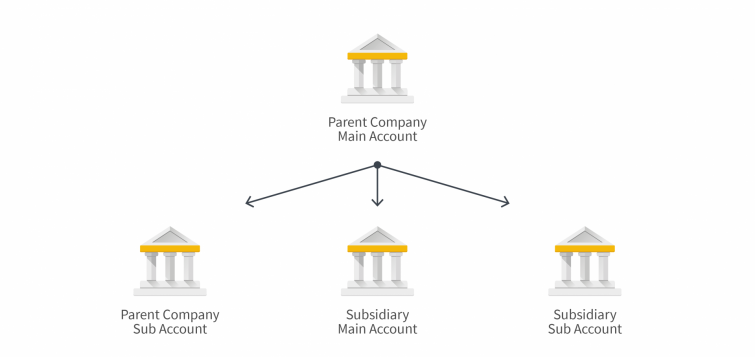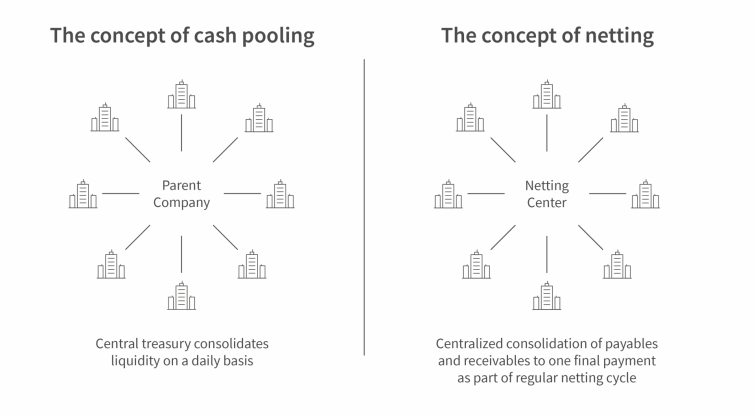Leveraging Netting and Cash Pooling for an In-house Bank

Using liquidity most efficiently is in every company’s best interest. Ways to pool liquidity that help companies optimize liquidity planning and management include netting and cash pooling. Companies with existing cash pools can go a step further and completely eliminate intercompany cash flows by implementing netting. Settlement on intercompany accounts at the end of a netting run replaces physical bank account transfers. This process establishes a de-facto in-house bank with all the associated benefits leveraging netting and cash pooling.
Further reading: Netting: An Immersive Guide to Global Reconciliation
The concept of cash pooling
Cash pooling refers to the consolidation of liquidity within one group: Companies can deduct funds from entities with surplus liquidity and provide intercompany loans to entities who are short of funds. Central treasury is usually the one to offset balances.
Technically, this is realized by setting up a master account, which companies use to manage their subsidiaries’ investments and borrowing. Zero balancing, the most common type of cash pooling, operates with sweeps that leave all subsidiary accounts with a balance of zero. End-of-day sweeps automatically pool and consolidate the balances of all accounts on one single account.
Companies have the option of setting up cross-currency cash pools. The more common approach is cash pools in one currency, i.e. one cash pool for USD, one for EUR etc. Cash pooling centralizes FX management, which enables efficient, group-wide hedging.

The concept of netting
Companies who use netting offset payables and receivables between two parties and consolidate them in one final payment. Netting with more than two parties involves a central netting center that reconciles payables and receivables and consolidates them. The netting center is usually part of the central treasury.
A netting process can be divided into four steps:
1) Data import
Payables and receivables are imported from ERP systems to the netting system. Alternatively, entities submit their data to the netting center.
2) Data reconciliation
The netting system automatically reconciles the payables and receivables that have been submitted. The result is represented in a netting statement.
3) Information from netting center
Netting participants receive the netting statement detailing the end sum in the requested currency.
4) Close of cycle
The netting center distributes payments to subsidiaries with positive balances. Subsidiaries with negative balances make one netted payment to the netting center.
Companies normally use netting to settle intercompany trade. However, netting can also involve non-group participants.
For currency netting, companies can use pre-defined internal exchange rates. These rates are determined before the start of a netting cycle and apply to all participants. Just as for cash pooling, this centralizes FX management and transfers it to the central treasury.

The next step: cash pooling and netting as building blocks of an in-house bank
Taking a look at the elements that cash pooling and netting have in common, you quickly realize: Both make use of a central intermediary to balance liquidity internally, i.e. consolidate and pool it.
Netting in itself reduces the number of payment transactions to one final transaction for each participant, while cash pooling eliminates even this final transaction. Instead of actually making a payment to the cash pool at the end of the netting run, the sum is only booked on the participant’s account. You do not need to make any physical payment. This way, central treasury becomes the netting participants’ financial intermediary. Effectively, you have established an in-house bank.
The advantages of an in-house bank
An in-house bank, set up by way of cash pooling and netting, provides a number of advantages to businesses:
- Minimal cash-in-transit
- Minimal transaction fees
- Minimal FX costs
- Automated processes
- Optimized cash and FX management
The advantages of an in-house bank with Coupa Treasury
An in-house bank has the potential to transform a business – especially in combination with a treasury management system like Coupa Treasury that promotes collaboration.
Coupa Treasury integrates all entities in all processes, while central treasury maintains overall control. On one hand, this collaboration relieves entities of the burden of complex liquidity planning, payments and FX hedging processes. On the other hand, this kind of collaboration in one system maximizes transparency and visibility of group-wide liquidity and exposure in real time.
Coupa Treasury enables subsidiaries and the central treasury to take care of all tasks together, from cash positioning to processing payments or financing and hedging.
This is an overview of what they achieve together:
- Group-wide financial status, mobile and in real time – for all entities and the group
- Visibility of all cash flows in all entities
- Simplified and optimized POBO process
- Visibility of short- and long-term forecasts
- Efficient back-to-back hedging
- Cash pooling and centralized FX management, minimized exposure
- Centralized exposure of IHB clients in order to minimize external deals
- Straightforward administration of virtual intercompany accounts
- Processing of intercompany deals and netting payments directly on virtual accounts
Netting, cash pooling, in-house bank: your way forward
Companies who implement netting or cash pooling significantly boost the efficiency of their cash and FX management. Companies who implement both, effectively create an in-house bank.
The collaborative approach of Coupa Treasury helps you set up an in-house bank with very little administrative effort and brings transparency, visibility, efficiency and security to both subsidiaries and the central treasury.
Want to learn more about our powerful treasury solutions? Time to discover Coupa Treasury.
